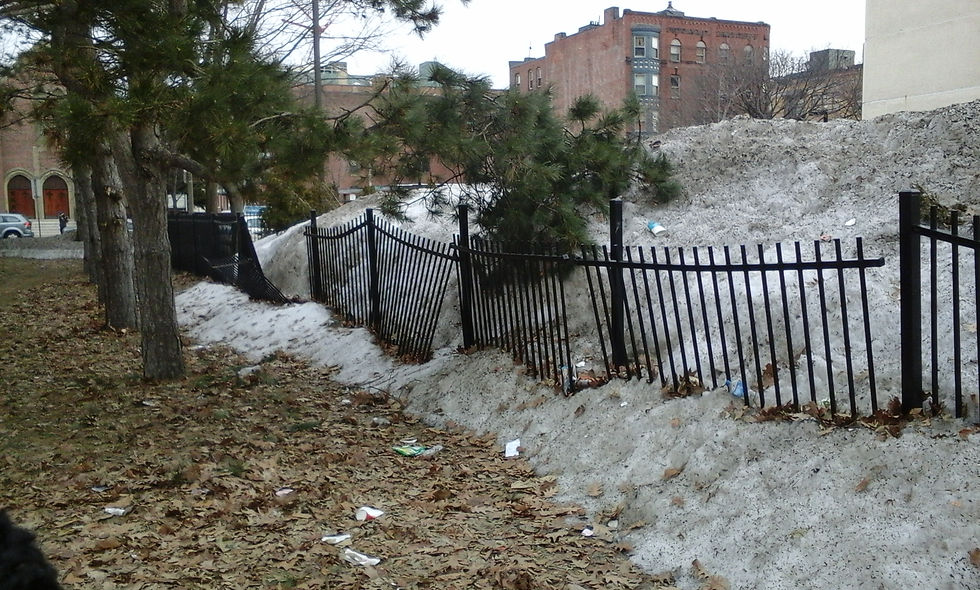Creative Destruction
- KB
- May 21, 2018
- 3 min read
With the passing of each new spring day and the emergence of the underlying urban surface of Boston, the curiousness and cleverness of the word chosen by Chris Reed for his office - Stoss Landscape Urbanism - becomes increasingly apparent. Derived from the German word ‘stossen’ (to push), stoss is taken to mean ‘receiving or having received the thrust of a glacier or other impulse’ [1]. Quite fitting, really. In 2000 Stoss began in, and continues to pursue, a position of eminence in the branch of design known as Landscape Urbanism, pushing for a radical reassessment of how landscapes can and should operate as the inseparable machinery of contemporary urban environments.

While not completely accurate as a metaphor, the destruction caused by the heavy snowfall in Boston over this winter (the snowiest since records began in 1872 [2]) could be seen as allegorical to the action of a glacier. The long term impact of this kind of seasonal interference with civic function and the destruction of material assets may not yield any immediately identifiable benefits, but a sense of ‘creative destruction’ could be gleaned if thought about from a longer term philosophical position. As described by Joseph Schumpeter, in a socio-economic sense creative destruction is the renewal of the economic doctrine and societal function through innovation and supercedence; an intrinsic characteristic of capitalism [3]. When armed with the assumption that destruction is necessary for progress, one could take a position of optimism when finding that their fence had been utterly destroyed by the accumulation of snow, or that a glacier had ground their favourite rock face into dust. Maybe that’s the nudge they needed to get that new fence they’ve been dreaming about, or maybe they don’t even need a fence at all?
As the name suggests, Stoss is in the business of challenging, and even creatively destroying, presumptions about the capacity of landscapes to perform an integral function in contemporary societies. At the scale of the small suburban (e.g. Sweeney Park, Boston,) or of the comprehensive strategic framework (e.g. Detroit: Future City) their intention is to break ground and redefine what it is to shape urban landscapes.
The optimism, the hubris, and, retrospectively, the pertinence this term is something that one can easily miss due to its esoteric nature. But perhaps even that seemingly unfortunate aspect strikes a convenient parallel to the ecological phenomena to which it relates. The immensity and agency of the glacial force can only be fully understood retrospectively and in the abstract, due to it’s sheer physical and temporal scale; it’s operation is unknowable in real-time, unperceivable on a human scale. Its impact on biological, geological and atmospheric systems reaches far beyond its physical location, and the cycles which it initiates and perpetuates - the obliteration of rock to enrich future soils, the capture and storage of atmospheric gases to regulate the chemical composition of the air, the reflection of solar radiation to regulate thermal gains, the containment of freshwater in a solid phase for later release as liquid - are crucial to the stability and renewal of the environment that we depend on. Lofty aspirations, but in essence this is akin to the intention of Landscape Urbanism as it has been from the outset.
Stoss and their contemporaries aim to redefine the way cities function by flexing the muscle that urban landscapes can be endowed with if given due time, resources, and confidence. Through the lense of Landscape Urbanism, it is by capitalising on the inherent and generated potentials of landscapes that we can equip our urban environments with the capacity to respond to the rapidly complexifying urban challenges of the present and future.
References:
[1] stoss. (n.d.) American Heritage® Dictionary of the English Language, Fifth Edition. (2011). Retrieved April 3 2015 from http://www.thefreedictionary.com/stoss
[2] Abel, D. and Emack-Bazelais, N. (March 15, 2015) Boston’s winter vaults to top of snowfall. Retrieved April 3 2015 from recordshttp://www.bostonglobe.com/metro/2015/03/15/parade-day-snow-but-snowiest-winter-record-unlikely-today/BCxfh7yPtIrxtHVzty5sPM/story.html
[3] Schumpeter, J. (2010). Capitalism, socialism and democracy (Routledge classics). London: Routledge.



Comments